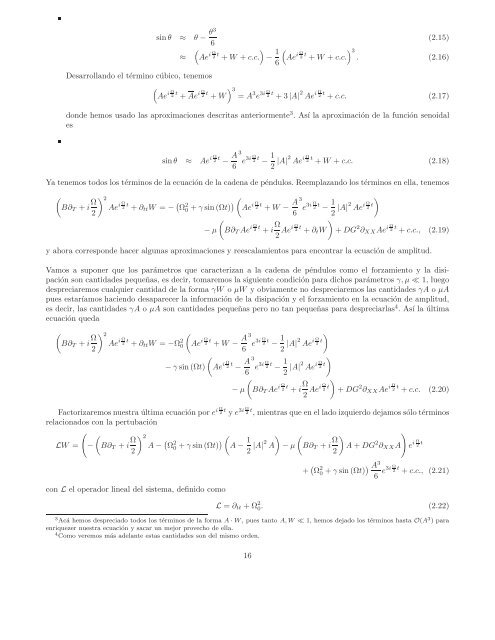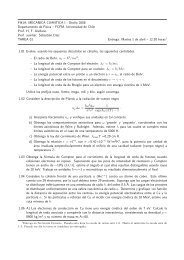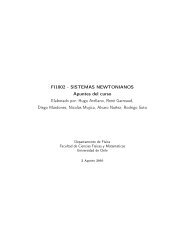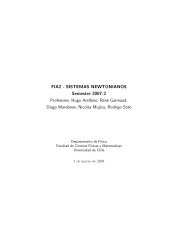universidad de chile dinámica de dominios en sistemas forzados ...
universidad de chile dinámica de dominios en sistemas forzados ...
universidad de chile dinámica de dominios en sistemas forzados ...
You also want an ePaper? Increase the reach of your titles
YUMPU automatically turns print PDFs into web optimized ePapers that Google loves.
sin θ ≈ θ − θ3<br />
6<br />
Desarrollando el término cúbico, t<strong>en</strong>emos<br />
≈<br />
<br />
Ω i<br />
Ae 2 t + W + c.c.<br />
<br />
Ae iΩ<br />
2 t + Ae iΩ<br />
2 t 3 + W<br />
<br />
(2.15)<br />
− 1<br />
<br />
Ω i<br />
Ae 2<br />
6<br />
t 3 + W + c.c. . (2.16)<br />
= A 3 e 3iΩ<br />
2 t + 3 |A| 2 Ae iΩ<br />
2 t + c.c. (2.17)<br />
don<strong>de</strong> hemos usado las aproximaciones <strong>de</strong>scritas anteriorm<strong>en</strong>te 3 . Así la aproximación <strong>de</strong> la función s<strong>en</strong>oidal<br />
es<br />
Ω i<br />
sinθ ≈ Ae 2 t − A<br />
3<br />
Ω 3i<br />
e 2<br />
6<br />
t − 1<br />
2 |A|2 Ae iΩ<br />
2 t + W + c.c. (2.18)<br />
Ya t<strong>en</strong>emos todos los términos <strong>de</strong> la ecuación <strong>de</strong> la ca<strong>de</strong>na <strong>de</strong> péndulos. Reemplazando los términos <strong>en</strong> ella, t<strong>en</strong>emos<br />
<br />
B∂T + i Ω<br />
2<br />
2 Ae iΩ<br />
2 t + ∂ttW = − Ω 2 <br />
<br />
0 + γ sin (Ωt)<br />
Ae iΩ<br />
2 t + W − A<br />
6<br />
<br />
− µ B∂TAe iΩ<br />
2 t + i Ω<br />
2<br />
3<br />
Ω 3i<br />
e 2 t − 1<br />
Aei Ω<br />
2 t + ∂tW<br />
2 |A|2 Ae iΩ<br />
2 t<br />
<br />
<br />
+ DG 2 ∂XXAe iΩ<br />
2 t + c.c., (2.19)<br />
y ahora correspon<strong>de</strong> hacer algunas aproximaciones y reescalami<strong>en</strong>tos para <strong>en</strong>contrar la ecuación <strong>de</strong> amplitud.<br />
Vamos a suponer que los parámetros que caracterizan a la ca<strong>de</strong>na <strong>de</strong> péndulos como el forzami<strong>en</strong>to y la disipación<br />
son cantida<strong>de</strong>s pequeñas, es <strong>de</strong>cir, tomaremos la sigui<strong>en</strong>te condición para dichos parámetros γ, µ ≪ 1, luego<br />
<strong>de</strong>spreciaremos cualquier cantidad <strong>de</strong> la forma γW o µW y obviam<strong>en</strong>te no <strong>de</strong>spreciaremos las cantida<strong>de</strong>s γA o µA<br />
pues estaríamos haci<strong>en</strong>do <strong>de</strong>saparecer la información <strong>de</strong> la disipación y el forzami<strong>en</strong>to <strong>en</strong> la ecuación <strong>de</strong> amplitud,<br />
es <strong>de</strong>cir, las cantida<strong>de</strong>s γA o µA son cantida<strong>de</strong>s pequeñas pero no tan pequeñas para <strong>de</strong>spreciarlas 4 . Así la última<br />
ecuación queda<br />
<br />
B∂T + i Ω<br />
2<br />
2 Ae iΩ<br />
2 t + ∂ttW = −Ω 2 <br />
0 Ae iΩ<br />
2 t + W − A<br />
<br />
− γ sin (Ωt) Ae iΩ<br />
2 t − A<br />
6<br />
− µ<br />
6<br />
3<br />
Ω 3i<br />
e 2 t − 1<br />
2 |A|2 Ae iΩ<br />
2 t<br />
<br />
3<br />
e 3iΩ<br />
2 t − 1<br />
2 |A|2 Ae<br />
Ω i 2 t<br />
<br />
<br />
B∂TAe iΩ<br />
2 t + i Ω<br />
2 AeiΩ2<br />
t<br />
<br />
+ DG 2 ∂XXAe iΩ<br />
2 t + c.c. (2.20)<br />
Factorizaremos nuestra última ecuación por e iΩ<br />
2 t y e 3iΩ<br />
2 t , mi<strong>en</strong>tras que <strong>en</strong> el lado izquierdo <strong>de</strong>jamos sólo términos<br />
relacionados con la pertubación<br />
<br />
LW = − B∂T + i Ω<br />
2 A −<br />
2<br />
Ω 2 <br />
<br />
0 + γ sin (Ωt) A − 1<br />
2 |A|2 <br />
A − µ B∂T + i Ω<br />
<br />
A + DG<br />
2<br />
2 <br />
∂XXA<br />
con L el operador lineal <strong>de</strong>l sistema, <strong>de</strong>finido como<br />
Ω i<br />
e 2 t<br />
+ Ω 2 0 + γ sin (Ωt) A3 6 e3iΩ2<br />
t + c.c., (2.21)<br />
L = ∂tt + Ω 2 0 . (2.22)<br />
3 Acá hemos <strong>de</strong>spreciado todos los términos <strong>de</strong> la forma A · W, pues tanto A, W ≪ 1, hemos <strong>de</strong>jado los términos hasta O(A 3 ) para<br />
<strong>en</strong>riquezer nuestra ecuación y sacar un mejor provecho <strong>de</strong> ella.<br />
4 Como veremos más a<strong>de</strong>lante estas cantida<strong>de</strong>s son <strong>de</strong>l mismo or<strong>de</strong>n.<br />
16





